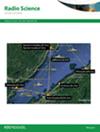A review on unlocking performance insights for next generation connectivity with AI in 6G communication
IF 1.5
4区 地球科学
Q3 ASTRONOMY & ASTROPHYSICS
引用次数: 0
Abstract
The rapid expansion of 6G communication networks provides a disruptive potential to address the increasing need for ultra-fast, protected, and reliable connectivity. This review study critically explores three essential domains: Privacy and security, throughput and efficiency, and latency and signal-to-noise ratio (SNR) that are fundamental to the success of 6G systems. The interrelated structure for 6G, combined with the growth of IoT devices also decentralized architectures, raises the risk of data breaches along with network vulnerabilities, necessitating the development of AI-powered privacy-preserving frameworks and adaptive security mechanisms. Furthermore, with 6G's promise of unprecedented throughput, this paper explores the role of intelligent spectrum management and resource allocation techniques to optimize bandwidth utilization and ensure high-efficiency transmission in dynamic network environments. Furthermore, obtaining ultra-low latency and maintaining a high SNR is critical for live applications like self-navigating devices and immersive technologies, where any delay or signal loss can have a major impact on performance. This review highlights existing research gaps in these areas and presents a comprehensive analysis of AI-driven solutions, setting a pathway for future advancements in scalable, high-throughput, and low-latency 6G architectures.关于在6G通信中解锁下一代AI连接的性能见解的综述
6G通信网络的快速扩展为满足对超高速、受保护和可靠连接日益增长的需求提供了颠覆性潜力。本综述研究批判性地探讨了三个基本领域:隐私和安全、吞吐量和效率、延迟和信噪比(SNR),这是6G系统成功的基础。6G的相关结构,加上物联网设备和分散架构的增长,增加了数据泄露和网络漏洞的风险,因此有必要开发人工智能支持的隐私保护框架和自适应安全机制。此外,鉴于6G有望实现前所未有的吞吐量,本文探讨了智能频谱管理和资源分配技术在优化带宽利用和确保动态网络环境下的高效传输中的作用。此外,获得超低延迟和保持高信噪比对于自动导航设备和沉浸式技术等实时应用至关重要,在这些应用中,任何延迟或信号丢失都会对性能产生重大影响。本综述强调了这些领域的现有研究差距,并对人工智能驱动的解决方案进行了全面分析,为未来可扩展、高吞吐量和低延迟6G架构的发展铺平了道路。
本文章由计算机程序翻译,如有差异,请以英文原文为准。
求助全文
约1分钟内获得全文
求助全文
来源期刊

Radio Science
工程技术-地球化学与地球物理
CiteScore
3.30
自引率
12.50%
发文量
112
审稿时长
1 months
期刊介绍:
Radio Science (RDS) publishes original scientific contributions on radio-frequency electromagnetic-propagation and its applications. Contributions covering measurement, modelling, prediction and forecasting techniques pertinent to fields and waves - including antennas, signals and systems, the terrestrial and space environment and radio propagation problems in radio astronomy - are welcome. Contributions may address propagation through, interaction with, and remote sensing of structures, geophysical media, plasmas, and materials, as well as the application of radio frequency electromagnetic techniques to remote sensing of the Earth and other bodies in the solar system.
 求助内容:
求助内容: 应助结果提醒方式:
应助结果提醒方式:


